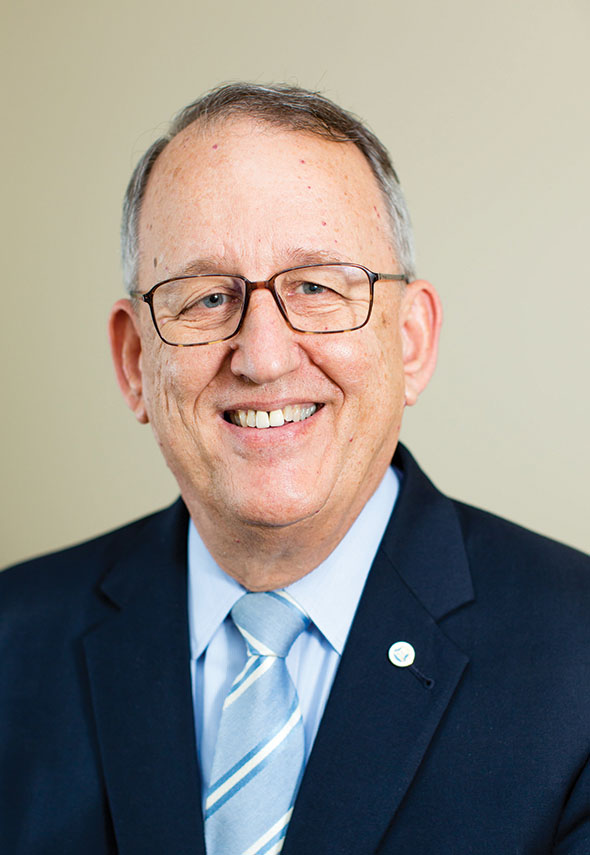Dad Was Right
Posted on Nov. 11, 2019I spotted something odd when Dad and I were in a retail store when I was 6. I pointed and said, “Daddy, what is that?” I had never seen a “Whites Only” sign hanging over a water fountain. Placing his comforting hand on my shoulder, Dad responded, “Doug, it is wrong, and it will change in your lifetime.”

Douglas S. Dibbert ’70
In high school, I recall only one black student running for any student council office in my three years at Fayetteville Senior High School. Most black students attended Fayetteville’s E.E. Smith High School, where the youngest of my four brothers graduated a few years later.
Like most students, in my first year at Carolina I enthusiastically watched classmate Charles Scott ’70 excite fans as a member of the freshman men’s basketball team. Kelly M. Alexander Jr. ’70 was the first black UNC student I recall meeting. (Alexander went on to earn his MPA at Carolina and today is in his seventh term as a member of the N.C. House.)
When racial tensions grew across the country after the assassination of the Rev. Martin Luther King Jr., urban centers became the focus of much of the unrest. During the Democratic National Convention in 1968, I was in Boston’s Roxbury neighborhood as part of Project Cornerstone. I was the only Southerner among about two dozen students from Ivy League and New England schools, and we lived on Hollander Street — just off Blue Hill Avenue — a block from where Malcolm X once lived. During the day, we worked in the community, with seminars in the evenings. I was troubled by an exchange I had with a young black child who drew a picture of himself and me. When I asked him why he’d drawn me with eyes, a nose, a mouth and ears but had only drawn a simple circle for his face, he responded: “Because you’re important. I’m not.”
Then-Professor Joel Schwartz, winner of multiple teaching awards, grew up in Roxbury when it was a Jewish ghetto. The focus of his research and teaching was the Soviet political system. Wanting to read and learn more about issues of race and poverty, he created UNC’s first course on the “Politics of Race and Poverty,” and I enrolled. We read and discussed a number of books, and the course included a community service component. I worked at Edgemont Community Center in Durham.
Since the late 1960s, Carolina has developed and added many additional courses across many disciplines that focus not only on our nation’s racial history but also bring increasing daylight to issues of race specific to our University. For instance, the Review’s editor, Regina Oliver ’75, is currently auditing a history course, “Race and Memory at UNC,” taught by Professor William Sturkey. Students in that class have been surprised to learn that the ownership and sale of slaves provided two sources of early funding for the University; these were crucial sources of revenue in the absence of significant state appropriations at that time. First, through the doctrine of escheats, real property would revert to the state when a person died without heirs — and enslaved people were considered property. And second, cases of delinquent debt leading to arrearages meant the state could take and sell such property. In each case, in the early years of the University, agents would go out across the state to collect these people as property, sell them at auction and send the money to Chapel Hill, the state having designated this as a way to help establish the University. Often, these agents were members of the Board of Trustees, and many of those trustees owned people themselves.
There are many stations along UNC’s path to recognizing race in our history. The Unsung Founders Memorial was a gift of the class of 2002 and dedicated in 2005 to honor “The People of Color, Bond and Free — Who Helped Build The Carolina That We Cherish Today.”
In May 2015, the Board of Trustees voted to rename Saunders Hall to Carolina Hall, to develop new curation and education initiatives, and to place a 16-year freeze on renaming historic buildings. When then-Chancellor Carol L. Folt appointed a History Task Force to focus on McCorkle Place and Saunders Hall, she indicated that “an honest and thoughtful account of Carolina’s history will encourage people to reflect on how race, class and privilege have shaped the university and the nation.” More recently, Interim Chancellor Kevin Guskiewicz has announced the formation of a new commission, to be called “History, Race and A Way Forward,” to focus on the early founding and building of Carolina.
Meeting in Fayetteville in November 1789, the N.C. General Assembly approved the creation of The University of North Carolina; in that same year, George Washington became our nation’s first president. In 1793, the cornerstone of Old East was placed; also in that year, the cornerstone of the U.S. Capitol was placed.
Our University has evolved along with our nation. In “Modern Civilization,” in my first year at Carolina, we were taught about existentialism, and I’ve long remembered that people, like nations, are forever in the process of becoming. As I urged in “Respectfully Listening and Hearing” (November/December 2018 Review): “Let us listen respectfully to each other and really hear one another. Let us understand that each of us may be wrong, and each of us may be right. Because we have differences of opinion doesn’t make either of us wrong.”
Dad was right. That sign over the water fountain was wrong, and it did change. But there is more that is “wrong” that also must change. Carolina’s past, like our nation’s past, has much for which we are rightfully proud, and, yes — like our nation, our University has not always exemplified our highest or most noble values. Our journey continues, for we are forever “in the process of becoming.”
Yours at Carolina,

Douglas S. Dibbert ’70
